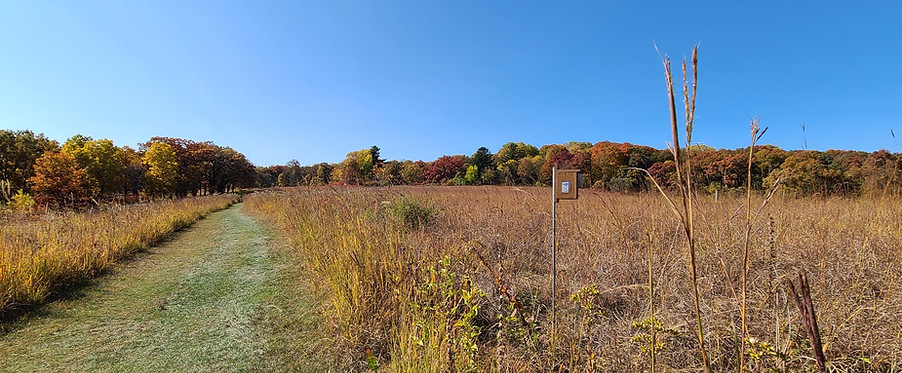Monitoring A Trail

Once your trail or boxes are up and ready, it is important to monitor them. This will allow the bluebirds to thrive in the best possible conditions.
Blue birders are urged to monitor all nest boxes under their care on a weekly basis using monitoring forms.
-
What are the best Locations for a Bluebird Trail?Location... Location... Location... Ideal sites: Short, sparse grass with interspersed trees Cemeteries Golf courses Parks Business park Bike trails Rail Road tracks
-
What are the best Perch Sites?One or more trees (10’ ideal) within 100’ (preferably closer) to the front or to one side of nest box (most hunting starts on a perch and these trees are vital for use as survival perches when chicks first fledge) Fences (barbed, electric, wooden) Electrical wires (no more than 30’ high preferred), clothes lines Boxes should be totally exposed to sun-light from sunrise until noon; thereafter, shading is permissible Need a territorial forage area of 1-3 acres of predominantly open habitat Noisy sites okay (interstates, other roadways, railroads, temporary air shows, church picnics) Roadways with limited traffic can be ideal nest box sites and adults and young chicks are rarely killed by traffic.
-
What are the best Perch Sites?One or more trees (10’ ideal) within 100’ (preferably closer) to the front or to one side of nest box (most hunting starts on a perch and these trees are vital for use as survival perches when chicks first fledge) Fences (barbed, electric, wooden) Electrical wires (no more than 30’ high preferred), clothes lines Boxes should be totally exposed to sun-light from sunrise until noon; thereafter, shading is permissible Need a territorial forage area of 1-3 acres of predominantly open habitat Noisy sites okay (interstates, other roadways, railroads, temporary air shows, church picnics) Roadways with limited traffic can be ideal nest box sites and adults and young chicks are rarely killed by traffic.
-
How close should the boxes be?Space no closer than 100-200 yards (1-3 acre territories needed): encourages Tree Swallow occupation if boxes are placed closer than this. Pairing reduces bluebird and increases swallow production/box
-
When should you relocate the boxes?Change the nest box position if there has been no bluebird nesting attempt in a season OR Change by the end of the following April (75-90% of nest boxes have been occupied by bluebirds by then) if no nesting has occurred by the end of April your 2nd nesting season, it is sign that your site is unappealing to bluebirds. But moving the to better nest sites still gives you a 50:50 chance of occupancy for the season.
-
What are the best Box Styles and Dimensions?Box Style/Dimensions: In “the wild”, bluebirds prefer to occupy old woodpecker holes that are not usually very large or deep Shallow, narrow boxes work best: 4-5” below the bottom of the hole as maximum depth 4 x 4”, 4 x 5” nesting platform (inside dimensions) No vents or keep vents closed until June 1 to prevent wind chill from killing eggs and/or chicks. The summer of 2012 showed that high temperatures can kill chicks in nest boxes. But cold weather has still proven to be more damaging than heat. Since it is likely that the changing climate assures high summer temperatures in the future, we recommend monitors consider making their boxes “convertible” by dropping side doors in the summer and replacing them at the end of the season. For Peterson Boxes: Holes can be drilled at the top of one side and a piece of “lathe board” placed over them until June 1. A single or pair of screws can be used to seal the openings during spring. The main thing to do here is to produce air circulation to prevent heat buildup as in an attic. On the other hand, in the southwestern part of the state where black flies are a problem, screens should be placed over the openings to prevent ease of black fly entry. Oval hole small enough to keep out starlings & cowbirds Don’t use predator guards on box fronts ( Too thick for bluebirds) or perches on boxes (used by predator birds such as sparrows & kestrels). Instead, use a predator guard on your mounting post or make the mounting post your predator guard (3/4” electrical conduit preferred. See detailed plans.
-
In which direction should the boxes be?Keep away from prevailing westerly winds (cools boxes) Use the same direction for all boxes. Cornell University has determined that directing the opening of a nest box to the north-east, east or southeast improves the fledging rate of Eastern Bluebirds in northern latitudes. Apparently, boxes pointed in that direction, heat up more quickly in the mornings in cold weather but do not collect as much heat from a southern exposure in summer.
-
What are the nest boxes recommended by BRAW?BRAW recommends using nest boxes that have proven to be highly attractive to bluebirds. These boxes are: Shallow (4-5” from bottom of hole to nesting platform) Narrow (4” x 4” nesting platforms), have oval openings (1 3/8” x 2 ¼”) Are unvented (vents can be opened after June 1 in areas where black flies are not prevalent). Any box that meets these specifications is recommended by BRAW. Read more…
Kent
Useful Resources
Life Cycles
Eastern Bluebirds
Photos by Jack Bartholomai
Tree Swallows
Photos by Pat Ready and Jack Bartholmai
Chickadees
Photos by Pat Ready and Jack Bartholmai
House Wren
Photos by Pat Ready and Jack Bartholmai
Eastern Bluebird, Tree Swallow, Black-capped
Chickadee, House Wren, House Sparrow
Species Identification of Cavity Nesters

The Monitoring Program
at Discovery Park, TN
This short educational video provides an example of what a Bluebird Monitoring Program is all about.
_edited.png)

